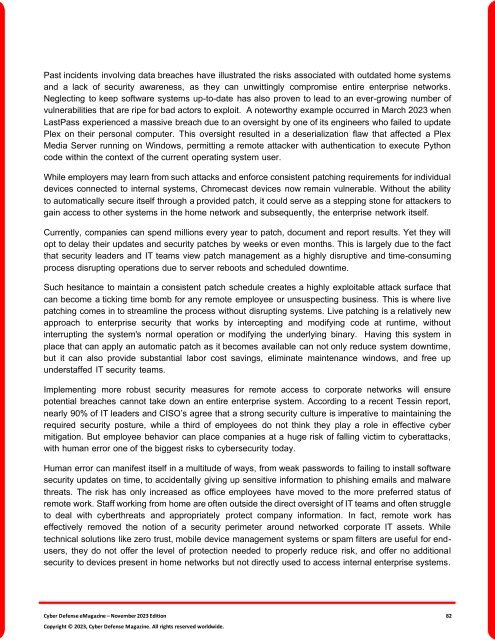The Cyber Defense eMagazine November Edition for 2023
Cyber Defense eMagazine November Edition for 2023 #CDM #CYBERDEFENSEMAG @CyberDefenseMag by @Miliefsky a world-renowned cyber security expert and the Publisher of Cyber Defense Magazine as part of the Cyber Defense Media Group as well as Yan Ross, Editor-in-Chief and many more writers, partners and supporters who make this an awesome publication! 196 page November Edition fully packed with some of our best content. Thank you all and to our readers! OSINT ROCKS! #CDM #CDMG #OSINT #CYBERSECURITY #INFOSEC #BEST #PRACTICES #TIPS #TECHNIQUES
Cyber Defense eMagazine November Edition for 2023 #CDM #CYBERDEFENSEMAG @CyberDefenseMag by @Miliefsky a world-renowned cyber security expert and the Publisher of Cyber Defense Magazine as part of the Cyber Defense Media Group as well as Yan Ross, Editor-in-Chief and many more writers, partners and supporters who make this an awesome publication! 196 page November Edition fully packed with some of our best content. Thank you all and to our readers! OSINT ROCKS! #CDM #CDMG #OSINT #CYBERSECURITY #INFOSEC #BEST #PRACTICES #TIPS #TECHNIQUES
You also want an ePaper? Increase the reach of your titles
YUMPU automatically turns print PDFs into web optimized ePapers that Google loves.
Past incidents involving data breaches have illustrated the risks associated with outdated home systems<br />
and a lack of security awareness, as they can unwittingly compromise entire enterprise networks.<br />
Neglecting to keep software systems up-to-date has also proven to lead to an ever-growing number of<br />
vulnerabilities that are ripe <strong>for</strong> bad actors to exploit. A noteworthy example occurred in March <strong>2023</strong> when<br />
LastPass experienced a massive breach due to an oversight by one of its engineers who failed to update<br />
Plex on their personal computer. This oversight resulted in a deserialization flaw that affected a Plex<br />
Media Server running on Windows, permitting a remote attacker with authentication to execute Python<br />
code within the context of the current operating system user.<br />
While employers may learn from such attacks and en<strong>for</strong>ce consistent patching requirements <strong>for</strong> individual<br />
devices connected to internal systems, Chromecast devices now remain vulnerable. Without the ability<br />
to automatically secure itself through a provided patch, it could serve as a stepping stone <strong>for</strong> attackers to<br />
gain access to other systems in the home network and subsequently, the enterprise network itself.<br />
Currently, companies can spend millions every year to patch, document and report results. Yet they will<br />
opt to delay their updates and security patches by weeks or even months. This is largely due to the fact<br />
that security leaders and IT teams view patch management as a highly disruptive and time-consuming<br />
process disrupting operations due to server reboots and scheduled downtime.<br />
Such hesitance to maintain a consistent patch schedule creates a highly exploitable attack surface that<br />
can become a ticking time bomb <strong>for</strong> any remote employee or unsuspecting business. This is where live<br />
patching comes in to streamline the process without disrupting systems. Live patching is a relatively new<br />
approach to enterprise security that works by intercepting and modifying code at runtime, without<br />
interrupting the system's normal operation or modifying the underlying binary. Having this system in<br />
place that can apply an automatic patch as it becomes available can not only reduce system downtime,<br />
but it can also provide substantial labor cost savings, eliminate maintenance windows, and free up<br />
understaffed IT security teams.<br />
Implementing more robust security measures <strong>for</strong> remote access to corporate networks will ensure<br />
potential breaches cannot take down an entire enterprise system. According to a recent Tessin report,<br />
nearly 90% of IT leaders and CISO’s agree that a strong security culture is imperative to maintaining the<br />
required security posture, while a third of employees do not think they play a role in effective cyber<br />
mitigation. But employee behavior can place companies at a huge risk of falling victim to cyberattacks,<br />
with human error one of the biggest risks to cybersecurity today.<br />
Human error can manifest itself in a multitude of ways, from weak passwords to failing to install software<br />
security updates on time, to accidentally giving up sensitive in<strong>for</strong>mation to phishing emails and malware<br />
threats. <strong>The</strong> risk has only increased as office employees have moved to the more preferred status of<br />
remote work. Staff working from home are often outside the direct oversight of IT teams and often struggle<br />
to deal with cyberthreats and appropriately protect company in<strong>for</strong>mation. In fact, remote work has<br />
effectively removed the notion of a security perimeter around networked corporate IT assets. While<br />
technical solutions like zero trust, mobile device management systems or spam filters are useful <strong>for</strong> endusers,<br />
they do not offer the level of protection needed to properly reduce risk, and offer no additional<br />
security to devices present in home networks but not directly used to access internal enterprise systems.<br />
<strong>Cyber</strong> <strong>Defense</strong> <strong>eMagazine</strong> – <strong>November</strong> <strong>2023</strong> <strong>Edition</strong> 82<br />
Copyright © <strong>2023</strong>, <strong>Cyber</strong> <strong>Defense</strong> Magazine. All rights reserved worldwide.

















